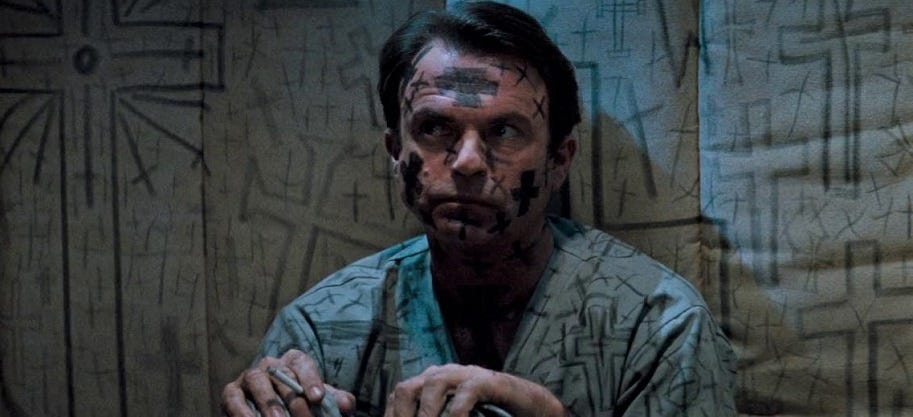The October Nasties: Week One (Nasties 2 - 11)
A continuing marathon of dread, bad taste and exquisite film making.
There’s no particular order or method to my madness during this month’s marathon of mayhem. Put simply, I’m in search of terror and beauty — and have had some success as the nasties roll on.
Satan’s Slaves (2017)
This Indonesian horror flick is a delightful mash-up of haunted house, zombie and folk-horror genres. At the center of the film is a satanic plot woven by a fertility cult that offers guaranteed conception at a steep price.
We follow a family after the loss of their matron as mourning turns to terror. Mom held secrets, and they will not be buried with her, imperiling a quartet of children who face the chaos left in the wake of her passing.
It’s not a perfect flick, but I’m recommending it for the incredibly unnerving moments manufactured by director Joko Anwar. Bonus points for one of the few effective jump-scares I’ve experienced in my recent years, built from the most classic of ghosts.
Offseason (2021)
The reviews for Offseason are not stellar and I totally get why. If you’re a horror bro looking for a scare, this atmospheric slow-burn isn’t going to tickle your terror-pickle. This flick is all cursed-village meets cosmic horror. And, if I’m being brutally honest, you’re better off watching Silent Hill for a better version of “lost in a foggy, deserted trauma town.”
But Offseason isn’t irredeemable. The amazing Richard Brake gets a dope, moody monologue and there are a few moments of Lovecraftian dread that are well done if somewhat unearned. And there are tons of well-shot scenes dripping with angst and weirdness. It’s an uneven flick and fine if you’ve got nothing else to watch on a spooky night.
Phantom of the Paradise (1974)
I slept on this completely insane Brian De Palma shocker for way too long. Given my predilections, I’m completely unsure how this horror rock musical slipped past me for most of my adult life. I was aware it was out there — it’s been on my watch-list forever (just never at the top). And while I’m devastated to have missed years watching this flick, I’m happy to report it will now be on heavy rotation.
If you are familiar with “Phantom of … “ plots, Faust and Portrait of Dorian Grey, you’ve already got a pretty good bead on where Phantom of the Paradise is going to take you. But the way Brian De Palma gets you to his unhappy destination is a bloody, glam treat. I don’t think there’s a single shot in Phantom of the Paradise that isn’t unhinged.
And it only gets better when you pair the wild visuals with Paul William’s acerbic songs and pretty okay acting beside a cast of capable ‘70s thespians like Paul Finley and Jessica Harper (later to star in Susperia).
This one deserves a deeper dive than I can provide now. One of my favorites of the month.
The Spine of Night (2021)
One of the best interviews I ever conducted during my middling journalism career was with animator and artist Ralph Bakshi. If you’re reading this, you probably know Bakshi from his animated Lord of the Rings, or from his famously x-rated Fritz the Cat.
Bakshi was a main-stream television animator before making some incredible cult classics, including high-fantasy mind-melters Fire and Ice, and Wizards. The Spine of Night is not a Bakshi film, but it has a Bakshi soul. That’s not simply because the movie uses Bakshi’s signature rotoscoping technique (a method of animation in which images are drawn over film footage of live actors). It also carries Bakshi’s transgressive tone. The Spine of Night is wildly gory and intensely bleak, with an other-worldly fantasy plot that’s fit for van-side airbrushing.
There is questing and warfare and magic and grotesque villains. There is a witch, a warlock and old Gods. The only thing it lacks is an appropriate stoner-rock soundtrack a la Heavy Metal. But given all that’s good in this flick, that can be forgiven.
Doctor X (1932)
Whatever happened to Fay Wray? Well, I mean, she died in Manhattan almost 20 years ago. But before that she was a pre-code scream queen is some amazing foundational horror flicks.
Doctor X sees Fay Wray playing the daughter of the titular doctor. Her dad is accused of being a moon-mad serial killer and she accompanies him to his spooky manor on a mission to suss out the real monster from a cast of mad scientists.
This movie is beautifully shot in early Technicolor with oodles of deep shadows amping up art-deco labs. The final monster is highly effective with his guttural prayer of “synthetic flesh,” shot through with the arc of a jacob’s ladder.
Mystery of the Wax Museum (1933)
Another Fay Wray joint! This one finds Wray working as a fast-talking reporter on the trail of a body-snatching murderer. That trail leads straight to the brand new wax museum, exported from London, and its grumpy, supposedly wheelchair-bound proprietor.
The villain is telegraphed from a million miles away, but the reveal of his monstrous form is pretty grotesque. A rare classic where Wray plays a hero rather than an imperiled victim, again in glorious pre-code technicolor glory.
Cure (1997)
If you’re looking for the foundations of the J-horror boom that gave us Ringu, Pulse and Ju-On: The Grudge, Cure is an excellent place to start. The unsettling flick from director Kiyoshi Kurosawa isn’t straight horror like the movies that came after, but inhabits the grim and forbidding Japan that they later leverage.
The plot involves a hard-nosed detective with a complicated home life desperately trying to find the culprit of a string of murders that share a method, but not a motive. Tying them together is an enigmatic amnesiac who shared conversation with the killers.
Cure asks what if humanity’s resentment and secret murderous desires could be unleashed by someone who thrived on chaos? It’s a frightening thought effectively explored through the history of hypnotism and a touch of the occult. And it’s all ramped up by incredibly well-done sound design and superb acting.
An arthouse horror thinker that will stick with me.
John Carpenter’s Apocalypse Trilogy
I had no idea that Carpenter’s The Thing was part of a trilogy until just this year. I’d not seen the other two in the series: Prince of Darkness and In The Mouth of Madness. So, I watched them back-to-back, in order.
The Thing is unassailable as one of the best horror films ever made. Despite showing us the monster from the start, it remains a gripping tale because after the reveal, the monster hides in the humans on screen. It’s simply brilliant.
But I’d never pegged The Thing as “cosmic horror” until I placed it in the context of the next two films. Both Prince of Darkness and In the Mouth of Madness are concerned with old threats from the beyond that want to wipe humanity away. As a set, the exploration of danger from the uncaring cosmic darkness is pretty effective.
That said, Prince of Darkness is a mess of a movie. There are some fine genre moments, sure, and the tangle of religion and quantum physics is ahead of it’s time. But as a film, it makes very little sense. Things happen with no rhyme or reason and the constant Carpenter synth barrage is unnecessary.
If you’re a completionist, or a die hard Donald Pleasance fan, Prince of Darkness will be an okay watch, but it might be better to skip to the incredible and criminally underrated In the Mouth of Madness. Of the three movies, In the Mouth of Madness has the biggest cosmic horror vibes.
The incredible Sam Neill has an amazing turn as an insurance investigator who becomes unhinged at the hands of a diabolical horror author with the ability to bend reality to his whims thanks to his eldritch masters. That’s a mouthful. But it’s also a marvelous foundation for a mind-bending movie with some of Carpenter’s best monsters. In terms of his flicks, this one has shot to the top of my favorites and might even come in number two in my favorite JC frights, after The Thing and before Halloween.












